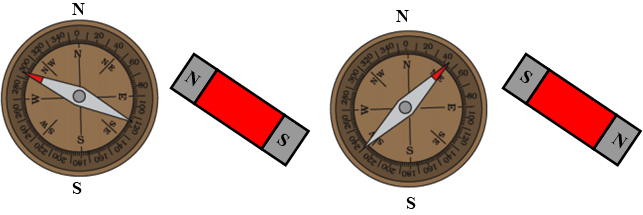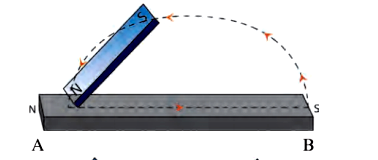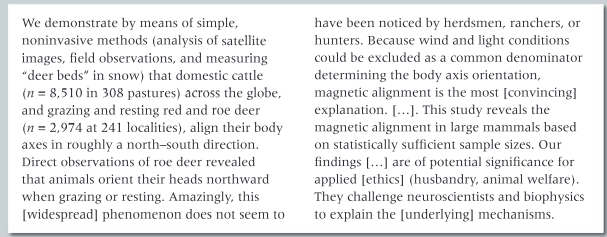IB myp 4-5 physics – Practice Questions- All Topics
Topic :Electromagnetism-Magnetism,Magnetic Fields
Topic :Electromagnetism– Weightage : 21 %
All Questions for Topic : Electric Fields,Static Electricity ,Magnetism,Magnetic Fields,Current,Power,Voltage,Electric Circuits,Electric and Magnetic Fields,Electromagnetic forces and induction
A magnet is a material or object that produces a magnetic field. This magnetic field is invisible but is responsible for the most notable property of a magnet. Magnetism is the force exerted by magnets where they attract or sometimes repel other magnetic materials.
Question
Elaborate on the cause of the observed deflection in a magnetic needle within a compass when it is brought near a bar magnet?

▶️Answer/Explanation
Ans:
The deflection observed in the magnetic needle inside a compass when moved alongside a small bar magnet is a result of the interaction between the magnetic field of the bar magnet and the magnetic needle.
The magnetic needle in a compass is itself a tiny magnet. It has a north pole and a south pole, and it is free to rotate, allowing the needle to align itself with the Earth’s magnetic field. When the compass is brought near a small bar magnet, the magnetic field of the bar magnet influences the magnetic needle.
According to the principles of magnetism, magnetic poles attract or repel each other. The needle experiences a magnetic force that causes it to align itself with the magnetic field produced by the bar magnet. The north pole of the compass needle will point in the direction where the magnetic field is stronger, and the south pole will point in the opposite direction.
As you move the compass along the length of the small bar magnet, the strength and direction of the magnetic field change. This variation in the magnetic field strength and direction causes the magnetic needle to continuously adjust its orientation. The deflection of the needle provides a visual indication of the changes in the magnetic field as you move around the bar magnet.
Question
Fill in the blanks.
▶️Answer/Explanation
Ans:
Magnetic field lines start from the north pole and end at the south pole outside the magnet.
Magnetic field lines do not cross each other.
The field strength is directly proportional to the line density in a particular area.
“Single Touch Procedure” in the context of magnetization. This technique involves rubbing one end of a magnet (e.g., the north pole) along a specific direction on an iron piece. The process is typically repeated several times, going from one end (e.g., end A) to the other (e.g., end B) and then back.
The purpose of this method is to align the magnetic domains in the iron piece in a preferred direction, effectively magnetizing it. As the magnet is rubbed along the iron, it induces a magnetic field in the material, causing the magnetic domains to align along the direction of the rubbing.
It’s a basic method used to create temporary magnets, and while it may not result in a highly strong or durable magnet, it does illustrate the principle of magnetization through the alignment of magnetic domains.

Question
Explain why a soft iron piece becomes magnetized.
▶️Answer/Explanation
Ans:
When a soft iron piece is subjected to a process that results in it becoming magnetized, it’s often due to the alignment of its atomic magnetic dipoles. In soft iron, the magnetic domains are relatively more mobile and can easily reorient themselves in response to an external magnetic field.
The process of magnetizing a soft iron piece can involve exposing it to a magnetic field or rubbing it with a magnet using methods like the Single Touch Method. When a magnet or a magnetic field is applied to the soft iron, the atomic magnets within the iron tend to align themselves in the direction of the external magnetic field.
Alignment of Magnetic Domains: Initially, the magnetic domains within the soft iron are randomly oriented, resulting in a net magnetic effect of nearly zero.
Application of External Magnetic Field: When an external magnetic field is applied (such as by placing a magnet near the iron or rubbing it with a magnet), the atomic magnets within the soft iron start to align themselves along the direction of the external magnetic field.
Induced Magnetism: The alignment of the magnetic domains creates a temporary magnetization in the soft iron. However, soft iron tends to lose its magnetism relatively easily when the external magnetic field is removed. This is because the atomic magnets can easily return to their random orientations.
Reversibility: Soft iron is considered “soft” because it can be easily magnetized and demagnetized. This property makes it useful in applications where a temporary or controllable magnetic effect is required, such as in electromagnetic devices like solenoids and transformers.
It’s important to note that soft iron is different from hard or permanent magnets, which retain their magnetism for longer periods. The magnetic properties of soft iron make it valuable in various applications where temporary magnetic effects are needed.
Question
What would be the likely outcome if someone attempted to magnetize a soft iron piece by alternately rubbing it with the north and south poles of a magnet?
▶️Answer/Explanation
Ans:
If someone were to rub a soft iron piece alternately with both poles of a magnet, the net effect would likely be a reduced or negligible magnetization. When the iron piece is rubbed alternately with the north and south poles of a magnet, the magnetic domains within the iron would experience conflicting influences. The magnetic domains would tend to align first in one direction during the north pole rubbing, and then attempt to realign in the opposite direction during the south pole rubbing.
However, due to the alternating influence, the overall alignment of magnetic domains would likely cancel out, resulting in a weaker or nonexistent net magnetic effect. In essence, the magnetic moments induced by each rubbing action may counteract each other, leading to a less effective magnetization process.
For efficient magnetization, it is generally more effective to consistently rub the iron piece in one direction with a specific pole of the magnet. This allows the magnetic domains to align in a coordinated manner, creating a more pronounced and cohesive magnetic effect.
Sensing magnetic fields
Scientists think that some animals are able to help themselves navigate by detecting the Earth’s magnetic field. However, they are not certain about how animals are able to detect magnetic fields. In 2008, some Czech scientists analyzed images from Google Earth and found that cows and deer seemed to prefer to align themselves with the Earth’s magnetic field.
The following text is from the introduction to a paper published in the Proceedings of the National Academy of Sciences of the United States of America, volume 105 on 9 September 2008. The paper was written by Sabine Begall, Jaroslav Cˇ ervený, Julia Neef, Oldrˇich Vojteˇch and Hynek Burda.

Question:
Write a bibliography reference for this paper.
▶️Answer/Explanation
Ans: Begall, S., Červený, J., Neef, J., Vojtěch, O. and Burda, H. 9 September 2008. Proceedings of the National Academy of Sciences of the United States of America, 105.
Question:
Discuss why non-invasive techniques are preferable when studying animal behavior.
▶️Answer/Explanation
Ans: Three from:
- To avoid harming/distressing the animals;
- To avoid interfering with their natural behaviours;
- This might invalidate the study;
- Appreciation that non-invasive techniques are sometimes more difficult to use.
Question:
Imagine that you are one of the scientists involved in this research. Write a report suggesting why you should be given more funding to continue this research. Explain the potential benefits of understanding why cows and deer prefer to align themselves to the Earth’s magnetic field.
▶️Answer/Explanation
Ans: Award marks on a scale from 0 (no answer) to 5 (good argument explaining benefit of understanding). Potential reasons might include possible medical benefits from better understanding of senses and better farming practices in keeping cows.